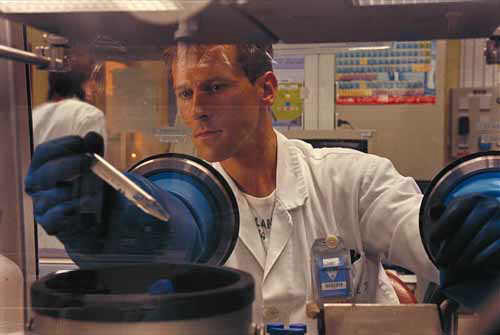Applying common sense rules according to radiation nature
The need for protection from radiation became apparent very soon after the discovery of radioactivity. After establishing the existence of his uranic rays, Henri Becquerel noticed that a tube of radioactive matter he carried around in his jacket was leaving marks on his skin that resembled the after-effects of sunstroke. It would be years before scientists finally grasped how dangerous such rays could be.

Tests in glove boxes
Handling highly radioactive materials requires reinforced radioprotection. In Marcoule CEA laboratory at in France, tests are conducted on new molecules designed to separate long-lived radioactive elements. These tests are done in a glove box to avoid contact with the products handled. The lead-glass window protects against gamma rays.
© CEA (Atalante)/Foulon
There are a variety of ways to remain suitably protected against radiations, most of which follow on from basic common sense and depend on the nature and strength of the rays involved.
When dealing with radioactive materials, there are simple rules that need to be obeyed. Firstly, as the danger decreases in the case of gamma emitters with the inverse square of the distance from the source, it is important not to get too close. When the source is intense, it is normal practice to place the source behind a specially strengthened wall, such as a lead screen in the case of gamma rays.
One should never touch directly a radioactive source nor a contaminated surface, but wear gloves. For the same reasons, in order to avoid contamination by alpha or beta emitters, it is important not to eat, drink or smoke in the vicinity of these emitters, and to wash hands and other parts of the body which may have been exposed.
Screens containing lead are frequently used to absorb released X rays and gamma rays. Radiologists conduct most of their research from behind lead-glass windows. It is important that radioactive substances be handled at a distance, and so most factories dealing with nuclear fuel or waste use robots rather than human workers.
In laboratories and workshops, radioactive sources are contained in lead caskets, carefully catalogued and scrupulously monitored by the nuclear security organizations. Particular care is taken during their transportation.
For workers who are exposed to radiation, every effort is made to minimise the exposure time: ranging from gloves and protection suits to masks preventing the inhalation of radioactive gas. All protective clothing that has been exposed to radiation is put to one side and disposed of along with other weakly radioactive waste.
Better protection can be achieved with a good understanding and precise measurements of the radiation doses. As most alpha and beta decays are quickly followed by gamma emission, the resulting radiation contains many constituents and can be complex. Good protection demands suitably refined detection techniques and an adequate monitoring.
It is easy to protect oneself from the charged particles if the thickness of the protective layers is greater than the maximum distance they can travel. If it is impossible in principle to bring neutral particles to an absolute stop. In practice, however, suitable shields can render the penetrative rays virtually harmless.
In France, the study of the risks radioactivity poses is one of the main missions of the Institute for Radioprotection and Nuclear Security (IRSN).
Other articles on the subject « Radioprotection »
Gamma Radioprotection
A penetrative radiation more difficult to absorb In the case of ingestion of radioactive substanc[...]
Gamma Attenuation
Attenuation of a gamma beam Of the three types of radiations, gamma rays are the most penetrative[...]
Gamma Absorption
Heavy materials for the absorption of gamma rays In terms of radioprotection mitigate gamma rays [...]
Radioprotection neutrons
A rare radiation, dangerous, penetrating, difficult to absorb The neutron radiation is more penet[...]
Radioactive Decontamination
Avoid all contact, ingestion and inhalation One of the tasks of radiation protection is the decon[...]
Justification and optimisation
In medicine, use of radiation must be justified The ‘Justification and Optimization » princ[...]
Reglementations and controls
Strict regulations for an efficient radioprotection Radioprotection has a long history. Its princ[...]
Dose legal limits
Applying the precautionary principle and setting cautious limits French regulations set at 1 mSv [...]
Actors in radioprotection
The actors and the basics of radioprotection regulations The rules of radiation protection are no[...]